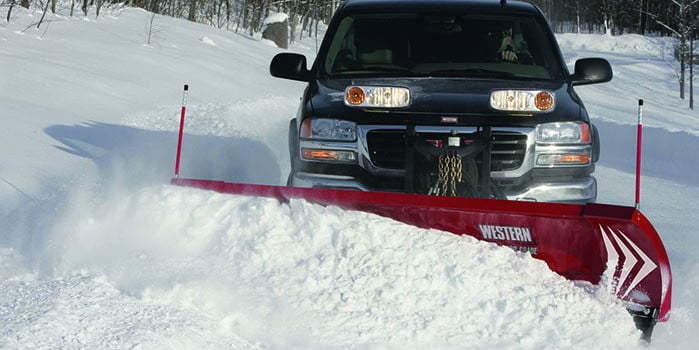Western Winged Plows vs V-Plows. Which is Right For You?
If you read the Internet forums, you will find plenty of opinions on V-plows, winged plows and which design is superior. Both types of plows give you greater versatility than a straight blade. Let’s take a look at what each brings to the table.
A Western V-plow blade is hinged in the middle, with hydraulic controls that adjust it from V to straight to scoop modes. In its V position, it breaks through deep snow banks and compacted “hard pack” with fewer passes. The V position can be reversed to create a scoop that allows the blade to carry more snow. Western V-plows can also be used in a straight blade position for back dragging, windrowing and other uses where a straight blade is desired. Many V-plows also feature flared blades that improve the plow’s snow rolling performance.
For greater carrying capacity there are several wing options. Wing extension kits can be added to many straight blade and V-plow models for moving more snow. Some manufacturers offer hydraulic winged plows that simply extend and retract between narrow and wider positions. Automatic winged plow models automatically reposition the wings based on the plowing angle for optimum plowing efficiency. They are especially suited for making beginners more productive, because they operate just like a straight blade.
Fully hydraulic-controlled winged plows provide the most versatility of all winged plows. Although they don’t provide the drift-breaking capability of a V-plow in V mode, they can offer greater carrying capacity, and additional flexibility. Winged plows with full hydraulic control allow you to independently or simultaneously extend the wings on either side of the plow to let you easily transition it from a narrow blade for clearing tight spots and transport, to a wider blade that reduces the number of passes to get a job done.
They also allow you to angle the wings forward, creating a scoop plow that can carry more snow than a V-plow. Unlike a Western V-plow which is fixed forward in the scoop position, a winged plow can fully angle left or right in scoop position to carry more snow around corners with less spill off.
For windrowing, a Western V-plow can be angled in straight-blade mode. With a hydraulically-controlled winged plow, you can angle the leading wing forward with the trailing wing in the full extended position. This configuration allows you to take a wider pass because it directs snow into the moldboard that would otherwise be lost as spillover.
Both V-plows and hydraulically-controlled winged plows give you increased versatility and save you time and money compared to a traditional straight blade. Each offers unique features and benefits that make them better suited to particular types of jobs. If most of your work involves long pushes moving a lot of snow or windrowing, a winged plow might make the most sense. A V-plow, meanwhile, may be the best choice for operators pushing through one plowed-in driveway after another or those dealing with heavy, deep snow.









